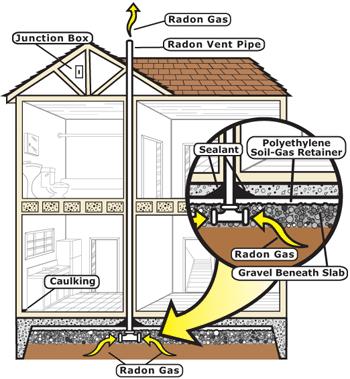Radon Resistant New Construction
Building Radon Resistant New Construction (RRNC) can save you money, improve the efficiency of your home, and improve the indoor air quality for you and your family.
RRNC incorporates techniques used in building new homes to seal soil gas entry points, prevent radon gas intrusion, and vent the radon outdoors. The system components of RRNC are incorporated into the design of the building which allows the features to be hidden from view. The RRNC technique may also help control basement moisture, by reducing the entry of water vapor through the slab. Talk to your contractor about RRNC.
How RRNC Reduces Radon Levels
Homes built with RRNC are built to "passively" reduce radon levels. These systems are intended to reduce soil gas entry and provide a route to vent the gas outdoors using no electricity. This passive system does not require energy or fans to move the radon and air. If necessary, a "passive" system can be upgraded to an "active" system by installing an electric fan to increase radon removal. If your radon tests show a high level of radon in your home, you can move to an active system.
System Components
RRNC relies on "passive" radon control. This passive system does not require energy or fans to move the radon and air. These systems reduce soil gas entry and piping to vent the gases outdoors. The basic components are listed and shown on figure:

- Gas Permeable Layer of Aggregate
This layer is placed beneath the slab or flooring system to allow the soil gas to move freely underneath the house and enter an exhaust pipe. In many cases, the material used is a 4-inch layer of clean gravel.
- Plastic Sheeting/Soil Gas Retarder
This is the primary soil gas barrier and serves to support any cracks that may form after the basement slab is cured. It is usually made of 6 mil polyethylene sheeting, overlapped 12 inches at the seams and fitted closely around all pipe, wire, or other penetrations. It is placed over the gas permeable layer of clean aggregate.
- Sealing and Caulking
Sealing and caulking all openings in the concrete foundation floor will reduce soil gas entry into the home. A polyurethane or silicone caulk should be used.
- PVC Vent Pipe
A vertical PVC vent pipe of 3-4" diameter can be connected to a vent pipe "T" which is installed below the slab in the aggregate. The vent pipe runs from the gas permeable layer (where the "T" is) through the house to the roof to safely vent radon and other soil gases above the house. A perforated PVC pipe can be attached to the "T" in the aggregate to allow radon gas to easily enter the piping. The vent pipe runs vertically through the building and terminates at least 12 inches above the roof's surface in a location at least 10 feet from windows or other openings and adjoining or adjacent buildings. On each floor of the home, the pipe should be labeled as a "Radon Reduction System".
- Junction Box
An electrical junction box is installed in the attic near the vent pipe. It is easier and cheaper to install electrical wiring during construction than adding it later. This power supply can be used if the passive radon control system needs to become activated by installing a fan once the home is tested for radon.
- Roof Flashing
Once the vent pipe exits the roof, roof flashing should be installed around the pipe to prevent leakage.
Next Steps After Installation
Once the home is constructed and the passive radon system is installed, a radon test should be performed in the lowest livable part of the house. Contact us at for a free RRNC test kit. To qualify, please have the name and address of the RRNC home builder available.
If the radon level is elevated, above the action level of 4.0pCi/L, the passive radon system can be converted to an "active" system by installing an electric radon fan. The fan should be wired into the electrical box that was installed during construction. This fan creates a suction on the system and pulls radon from beneath the slab of the home and vents it outside. A system warning device should be installed to alert you if the radon system malfunctions. The most common warning device is a u-tube manometer. This device shows whether the fan is operating, and therefore reducing the radon levels in the home.
Resources
- View radon publications that are available for order, including Build a Green Home.
- Radon Resistant New Construction - Buying a New Home? How to Protect Your Family From Radon
Contact Us
For additional information on RRNC, contact us at:
Center for Environmental HealthBureau of Environmental Radiation Protection
Empire State Plaza-Corning Tower, Room 1201
Albany, New York 12237 (518) 402-7556
radon@health.ny.gov